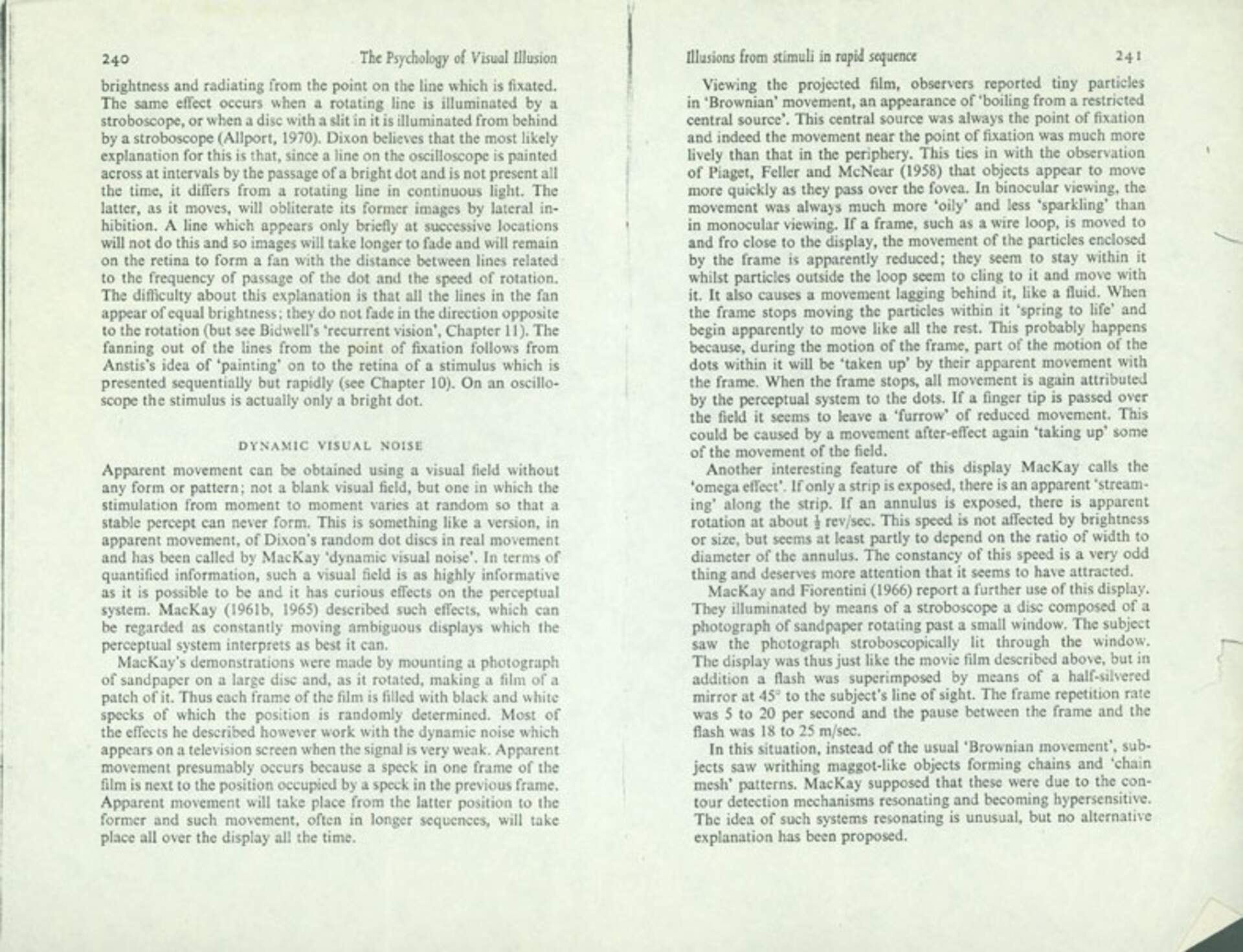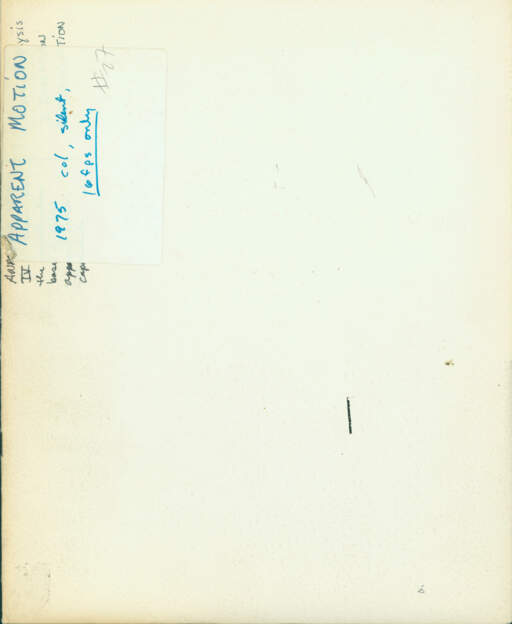Paul Sharits (1943-1993)Untitled (Article)
c. 1971-1975
printed ink on paper
11 x 8 1/2 inches
Gift of Christopher and Cheri Sharits, 2006
240 The Psychology of Visual Illusion Illusions from stimuli in rapid sequence
DYNAMIC VISUAL NOISE
Apparent movement can be obtained using a visual field without any form or pattern; not a blank viaul field, but one in which the stimulation from moment to moment varies at random so that a stable percept can never form. This is something like a version, in apparent movement, of Dixon’s random dot discs in real movement and has been called by MacKay ‘dynamic visual noise’. In terms of quantified information, such a visual field is as highly informative as it is possible to be and it has curious effects on the perceptual system. MaKay (1961b, 1965) described such effects, which can be regarded as constantly moving ambiguous displays which the perceptual system interprets as best it can.
MacKay’s demonstrations were made by mounting a photograph of sandpaper on a large disc and, as it rotated, making a film of a patch of it. Thus each frame of the film is filled with black and white specks of which the position is randomly determined. Most of the effects he decribed however work with the dynamic noise which appears on a television screen when the signal is very weak. Apparent movement presumably occurs because a speck in one frame of the film is next to the position occupied by a speck in the previous frame. Apparent movement will take place from the latter position to the former and such movement, often in longer sequences, will take place all over the display all the time.
Viewing the projected film, observers reported tiny particle in ‘Brownian’ movement, an appearance of ‘boiling from a restricted central source’. This central source was always the point of fixation and indeed the movement near the point of fixation was much more lively than that in the periphery. This ties in with the observation of Piaget, Feller and McNear (1958) that objects appear to move more quickly as they pass over the fovea. In binocular viewing, the movement was always much more ‘oily’ and less ‘sparkling’ than in monocular viewing. If a frame, such as a wire loop, is moved to and fro close to the display, the movement of the particle enclosed by the frame is apparently reduced; they seem to stay within it whilst particles outside the loop seem to cling to it and with it. It also causes a movement lagging behind it, like a fluid. When the frame stops moving the particles within it ‘spring to life’ and begin apparently to move like all the rest. This probably happens because, during the motion of the frame, part of the motion of the dots within it will be ‘taken up’ by their apparent movement with the frame. When the frame stops, all movement is again attributed by the perceptual system to the dots. If a finger tip is passed over the field it seems to leave a ‘furrow’ of reduced movement. This could be cause by a movement after-effect again ‘taking up’ some of the movement of the field.
Another interesting feature of this display MacKay calls the ‘omeg effect’. If only a strip is exposed, there is an apparent ‘streaming’ along the strip. If an annulus is exposed, there is apparent rotation at about ½ rev/sec. This speed is not affected by brightness or size, but seems at least partly to depend on the ratio of width to diameter of the annulus. The constancy of this speed is a very odd thing and deserves more attention that it seems to have attracted.
Mackay and Fiorentini (1966) report further use of this display. They illuminated by means of a stroboscope a disc composed of a photograph of sandpaper roating past a small window. The subject saw the photograph stroboscopically lit through the window. The display was thus just like the movie film described above, but in addition a flash was superimposed by means of a half-silvered mirror at 45° to the subject’s line of sight. The frame repetition rate was 5 to 20 per second and the pause between the frame and the flash was 18 to 25 m/sec.
In this situation, instead of the usual ‘Brownian movement’, subjects saw writhing maggot-like objects forming chains and ‘chain mesh’ patterns. MacKay supposed that these were due to the contour detection mechanisms resonation and becoming hypersensitive. The idea of such systems resonating is unusual, but no alternative explanation has been proposed.


